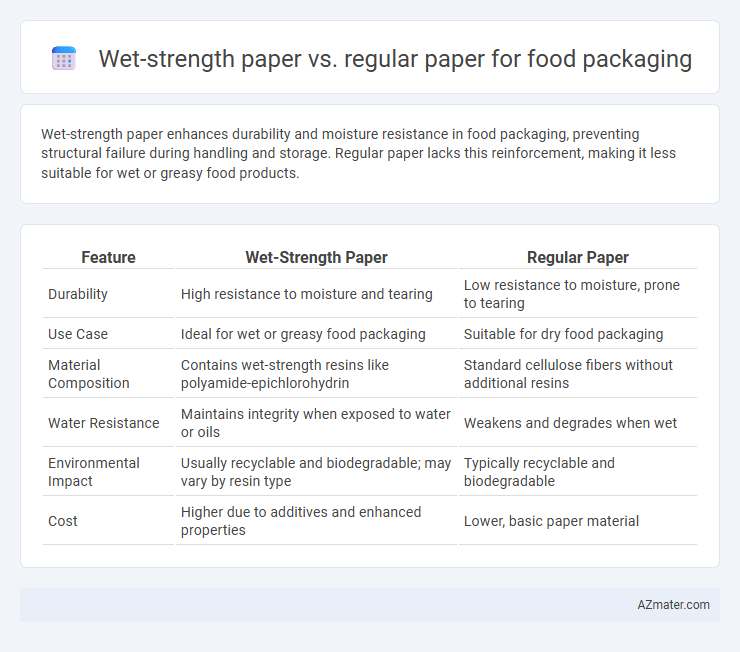Wet-strength paper enhances durability and moisture resistance in food packaging, preventing structural failure during handling and storage. Regular paper lacks this reinforcement, making it less suitable for wet or greasy food products.
Table of Comparison
| Feature | Wet-Strength Paper | Regular Paper |
|---|---|---|
| Durability | High resistance to moisture and tearing | Low resistance to moisture, prone to tearing |
| Use Case | Ideal for wet or greasy food packaging | Suitable for dry food packaging |
| Material Composition | Contains wet-strength resins like polyamide-epichlorohydrin | Standard cellulose fibers without additional resins |
| Water Resistance | Maintains integrity when exposed to water or oils | Weakens and degrades when wet |
| Environmental Impact | Usually recyclable and biodegradable; may vary by resin type | Typically recyclable and biodegradable |
| Cost | Higher due to additives and enhanced properties | Lower, basic paper material |
Understanding Wet-Strength Paper: Key Features
Wet-strength paper exhibits enhanced durability and resistance to moisture, making it ideal for food packaging exposed to wet or oily conditions. It contains special additives like wet-strength resins that maintain fiber bonding even when saturated, preventing paper breakage and maintaining structural integrity. Compared to regular paper, wet-strength variants offer superior performance in maintaining food safety and packaging reliability during handling and storage.
Regular Paper Explained: Characteristics and Limitations
Regular paper used in food packaging is primarily composed of cellulose fibers with little to no additives for moisture resistance, resulting in limited durability when exposed to liquids or humidity. Its porous structure leads to easy absorption of grease, water, and other contaminants, which can compromise the integrity and hygiene of food products. This lack of wet strength and barrier properties makes regular paper unsuitable for applications involving wet or greasy foods, where maintaining packaging strength and preventing leaks are critical.
Manufacturing Differences: Wet-Strength vs Regular Paper
Wet-strength paper for food packaging is manufactured using resin additives such as polyamide-epichlorohydrin (PAE) or melamine-formaldehyde to enhance fiber bonding and retain strength when exposed to moisture. Regular paper relies solely on hydrogen bonding between cellulose fibers, making it susceptible to weakening and disintegration upon contact with water or grease. The wet-strength process involves controlled chemical curing and higher drying temperatures to ensure durability, whereas regular paper follows a simpler, less chemically intensive manufacturing route.
Moisture Resistance: Why Wet-Strength Paper Excels
Wet-strength paper exhibits superior moisture resistance compared to regular paper, making it ideal for food packaging applications where exposure to water or humidity is frequent. The enhanced durability stems from chemical additives like polyamide-epichlorohydrin resins that reinforce fibers, preventing disintegration upon wetting. This property ensures food packaging maintains integrity, preventing leaks and preserving product freshness even in damp environments.
Food Safety and Hygiene Considerations
Wet-strength paper offers enhanced durability and resistance to moisture, making it ideal for food packaging applications where exposure to liquids or condensation is common. Regular paper lacks this moisture resistance, increasing the risk of contamination and compromising food safety due to its tendency to weaken and tear when wet. Using wet-strength paper helps maintain packaging integrity, reduces microbial contamination risks, and ensures hygienic protection for perishable and moisture-sensitive food products.
Durability in Packaging Applications
Wet-strength paper offers superior durability compared to regular paper, maintaining structural integrity and resistance to tearing when exposed to moisture or grease, making it ideal for food packaging applications like takeout containers and grease-resistant wraps. Regular paper, lacking enhanced wet-strength resins, tends to weaken and disintegrate under similar conditions, limiting its effectiveness in protecting food products during handling and transportation. The moisture resistance of wet-strength paper extends shelf life and preserves food quality, crucial for packaging oily or moist food items.
Cost Comparison: Analyzing Expenses and Value
Wet-strength paper for food packaging typically incurs higher initial costs than regular paper due to specialized resins enhancing moisture resistance and durability. Despite increased expenses, its extended shelf life and reduced risk of product damage often translate into lower overall costs by minimizing replacements and waste. Regular paper may offer short-term savings but can lead to higher long-term expenses when packaging integrity fails in humid or wet environments.
Sustainability and Environmental Impact
Wet-strength paper for food packaging offers enhanced durability and resistance to moisture, significantly reducing the need for plastic liners and contributing to lower plastic waste. It is often recyclable and biodegradable, supporting circular economy goals and minimizing landfill accumulation compared to regular paper that may degrade faster and cause contamination in recycling streams when wet. Companies adopting wet-strength paper help reduce environmental footprints by extending product life cycle and promoting sustainable packaging solutions aligned with consumer demand for eco-friendly materials.
Common Use Cases in Food Packaging
Wet-strength paper is commonly used in food packaging for items that require moisture resistance, such as fast food wrappers, deli bags, and beverage carrier trays, where durability against grease and liquids is essential. Regular paper is typically employed for dry food packaging like bakery boxes, cereal cartons, and snack bags, offering sufficient structural integrity without the need for enhanced moisture protection. The choice between wet-strength and regular paper hinges on the specific food's moisture exposure and packaging durability requirements.
Choosing the Right Paper for Food Packaging Needs
Wet-strength paper offers enhanced durability and resistance to moisture, making it ideal for packaging wet or greasy food items, unlike regular paper which tends to weaken when exposed to liquids. Choosing the right paper depends on the specific food's moisture content and the required shelf life, with wet-strength paper ensuring integrity and preventing leaks. This selection optimizes food safety, reduces contamination risk, and improves overall consumer experience in food packaging.

Infographic: Wet-strength paper vs Regular paper for Food packaging
 azmater.com
azmater.com